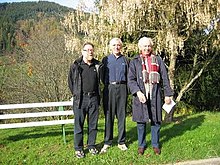Tom Archibald
William Thomas "Tom" Archibald (* 1950 ) is a Canadian mathematician .
Archibald studied languages and English at York University , then mathematics at the University of Waterloo with a bachelor's degree in 1971 and a master's degree from York University in 1978, and then history of science at the University of Toronto with a master's degree in 1980 and the doctorate with Jed Z. Buchwald 1987 (a sensible hypothesis: Aspects of action-at-a-distance electromagnetic theory 1820-1880). He was a lecturer at Acadia University from 1984 to 1987 , where he became Assistant Professor of Mathematics in 1987, Associate Professor in 1989 and Professor in 1997 and Head of the Mathematics Faculty from 1998 to 2003. He has been Professor of Mathematics at Simon Fraser University since 2005 , where he also teaches mathematics. From 2005 to 2010 he headed the mathematics faculty.
In 2004/05 he was a Senior Fellow at the Dibner Institute at MIT. He was visiting professor in Paris, Lille and Nancy. From 1995 to 2006 he was an adjunct professor at Dalhousie University . He was visiting researcher at the Deutsches Museum in Munich and at the Smithsonican in Washington DC, at the Cité des Sciences et de l'industrie in La Vilette for the CNRS , in Copenhagen (where he re-edited Erasmus Bartholin's treatise on birefringence) and Montreal.
He deals with the history of the applications of analysis in the natural sciences, especially of (partial) differential equations, and the relationship between France and Germany in the history of mathematics from 1840 to 1940. He also deals with the history of mathematics in Canada.
He is co-editor of Historia Mathematica .
Fonts
- with Rossana Tazzioli: Integral Equations between Theory and Practice: the cases of Italy and France to 1920 , Archive for History of Exact Sciences, Volume 68, 2014, pp. 547-597
- Differential equations, an historical overview to 1900 , in Hans Niels Jahnke , History of Analysis, AMS 2003 (as well as the chapter Analysis and physics: the case of boundary value problems ) (German edition, Spektrum Akademischer Verlag 1999)
- Connectivity and Smoke-Rings: Green's Second Identity in its First Fifty Years, Mathematics Magazine 1989, pp. 219–232 (reprinted in: M. Anderson, V. Katz, R. Wilson, who gave you the Epsilon?, MAA 2009)
- Charles Hermite and German Mathematics in France , in Karen Parshall , A. Rice (Ed.), Mathematics unbound: The evolution of an international mathematical research community 1800-1945, AMS 2002
- with L. Charbonneau: The History of Mathematics in Canada to 1945: a Preliminary Survey , in: Mathematics in Canada, Ottawa: Canadian Mathematical Society 1995 (and in G. van Brummelen (Ed.), Mathematics and the historian's craft, Springer 2005 )
- Differential Equations and Algebraic Transcendents: French efforts at the creation of a Galois Theory of Differential Equations 1880-1910 , Revue d'histoire des mathématiques, 2011, pp. 373-401.
- From attraction theory to existence theory: the evolution of potential-theoretical methods in the study of boundary-value problems, 1860-1890 , Revue d'histoire des mathématiques, Volume 2, 1996, pp. 101-128
- Riemann and the theory of electrical phenomena: Nobili's rings , Centaurus, Volume 34, 1992, pp. 247-271.
- Energy and the Mathematization of Electrodynamics in Germany, 1845-1875 , Archives Internationales d'Histoire des Sciences, Volume 39, 1989, pp. 276-308.
- Physics as a constraint on mathematical research: the case of potential theory and electrodynamics, 1840-1880 , in: The History of Modern Mathematics, New York, Academic Press, 1989, Volume 2, pp. 28-75.
- Tension and Potential from Ohm to Kirchhoff , Centaurus, Volume 31, 1988, pp. 141-163.
Web links
Individual evidence
- ↑ Tom Archibald in the Mathematics Genealogy Project (English)
| personal data | |
|---|---|
| SURNAME | Archibald, Tom |
| ALTERNATIVE NAMES | Archibald, William Thomas |
| BRIEF DESCRIPTION | Canadian mathematician |
| DATE OF BIRTH | 1950 |
